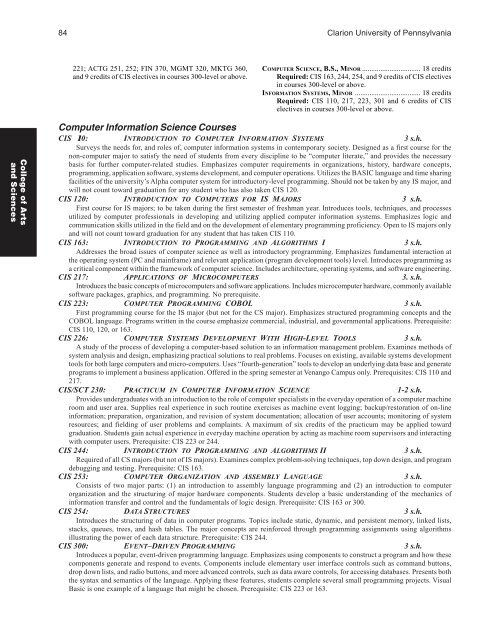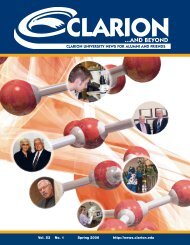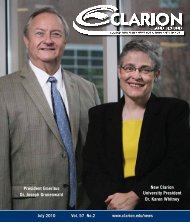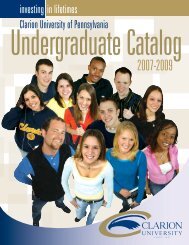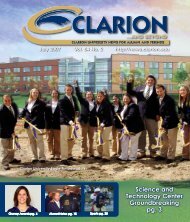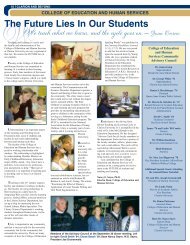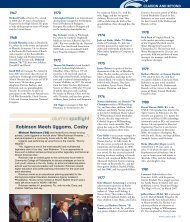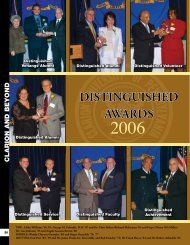Undergraduate - Clarion University
Undergraduate - Clarion University
Undergraduate - Clarion University
Create successful ePaper yourself
Turn your PDF publications into a flip-book with our unique Google optimized e-Paper software.
84 <strong>Clarion</strong> <strong>University</strong> of Pennsylvania<br />
221; ACTG 251, 252; FIN 370, MGMT 320, MKTG 360,<br />
and 9 credits of CIS electives in courses 300-level or above.<br />
COMPUTER SCIENCE, B.S., MINOR ................................ 18 credits<br />
Required: CIS 163, 244, 254, and 9 credits of CIS electives<br />
in courses 300-level or above.<br />
INFORMATION SYSTEMS, MINOR .................................... 18 credits<br />
Required: CIS 110, 217, 223, 301 and 6 credits of CIS<br />
electives in courses 300-level or above.<br />
College of Arts<br />
and Sciences<br />
Computer Information Science Courses<br />
CIS 10: INTRODUCTION TO COMPUTER INFORMATION SYSTEMS 3 s.h.<br />
Surveys the needs for, and roles of, computer information systems in contemporary society. Designed as a first course for the<br />
non-computer major to satisfy the need of students from every discipline to be “computer literate,” and provides the necessary<br />
basis for further computer-related studies. Emphasizes computer requirements in organizations, history, hardware concepts,<br />
programming, application software, systems development, and computer operations. Utilizes the BASIC language and time sharing<br />
facilities of the university’s Alpha computer system for introductory-level programming. Should not be taken by any IS major, and<br />
will not count toward graduation for any student who has also taken CIS 120.<br />
CIS 120: INTRODUCTION TO COMPUTERS FOR IS MAJORS 3 s.h.<br />
First course for IS majors; to be taken during the first semester of freshman year. Introduces tools, techniques, and processes<br />
utilized by computer professionals in developing and utilizing applied computer information systems. Emphasizes logic and<br />
communication skills utilized in the field and on the development of elementary programming proficiency. Open to IS majors only<br />
and will not count toward graduation for any student that has taken CIS 110.<br />
CIS 163: INTRODUCTION TO PROGRAMMING AND ALGORITHMS I 3 s.h.<br />
Addresses the broad issues of computer science as well as introductory programming. Emphasizes fundamental interaction at<br />
the operating system (PC and mainframe) and relevant application (program development tools) level. Introduces programming as<br />
a critical component within the framework of computer science. Includes architecture, operating systems, and software engineering.<br />
CIS 217: APPLICATIONS OF MICROCOMPUTERS 3. s.h.<br />
Introduces the basic concepts of microcomputers and software applications. Includes microcomputer hardware, commonly available<br />
software packages, graphics, and programming. No prerequisite.<br />
CIS 223: COMPUTER PROGRAMMING COBOL 3 s.h.<br />
First programming course for the IS major (but not for the CS major). Emphasizes structured programming concepts and the<br />
COBOL language. Programs written in the course emphasize commercial, industrial, and governmental applications. Prerequisite:<br />
CIS 110, 120, or 163.<br />
CIS 226: COMPUTER SYSTEMS DEVELOPMENT WITH HIGH-LEVEL TOOLS 3 s.h.<br />
A study of the process of developing a computer-based solution to an information management problem. Examines methods of<br />
system analysis and design, emphasizing practical solutions to real problems. Focuses on existing, available systems development<br />
tools for both large computers and micro-computers. Uses “fourth-generation” tools to develop an underlying data base and generate<br />
programs to implement a business application. Offered in the spring semester at Venango Campus only. Prerequisites: CIS 110 and<br />
217.<br />
CIS/SCT 230: PRACTICUM IN COMPUTER INFORMATION SCIENCE 1-2 s.h.<br />
Provides undergraduates with an introduction to the role of computer specialists in the everyday operation of a computer machine<br />
room and user area. Supplies real experience in such routine exercises as machine event logging; backup/restoration of on-line<br />
information; preparation, organization, and revision of system documentation; allocation of user accounts; monitoring of system<br />
resources; and fielding of user problems and complaints. A maximum of six credits of the practicum may be applied toward<br />
graduation. Students gain actual experience in everyday machine operation by acting as machine room supervisors and interacting<br />
with computer users. Prerequisite: CIS 223 or 244.<br />
CIS 244: INTRODUCTION TO PROGRAMMING AND ALGORITHMS II 3 s.h.<br />
Required of all CS majors (but not of IS majors). Examines complex problem-solving techniques, top down design, and program<br />
debugging and testing. Prerequisite: CIS 163.<br />
CIS 253: COMPUTER ORGANIZATION AND ASSEMBLY LANGUAGE 3 s.h.<br />
Consists of two major parts: (1) an introduction to assembly language programming and (2) an introduction to computer<br />
organization and the structuring of major hardware components. Students develop a basic understanding of the mechanics of<br />
information transfer and control and the fundamentals of logic design. Prerequisite: CIS 163 or 300.<br />
CIS 254: DATA STRUCTURES 3 s.h.<br />
Introduces the structuring of data in computer programs. Topics include static, dynamic, and persistent memory, linked lists,<br />
stacks, queues, trees, and hash tables. The major concepts are reinforced through programming assignments using algorithms<br />
illustrating the power of each data structure. Prerequisite: CIS 244.<br />
CIS 300: EVENT–DRIVEN PROGRAMMING 3 s.h.<br />
Introduces a popular, event-driven programming language. Emphasizes using components to construct a program and how these<br />
components generate and respond to events. Components include elementary user interface controls such as command buttons,<br />
drop down lists, and radio buttons, and more advanced controls, such as data aware controls, for accessing databases. Presents both<br />
the syntax and semantics of the language. Applying these features, students complete several small programming projects. Visual<br />
Basic is one example of a language that might be chosen. Prerequisite: CIS 223 or 163.


